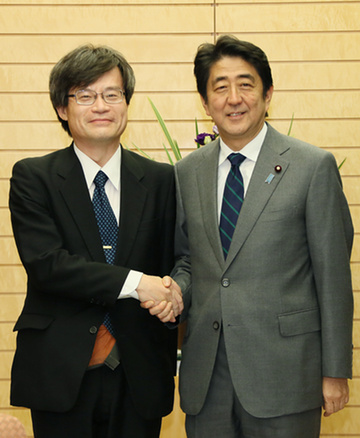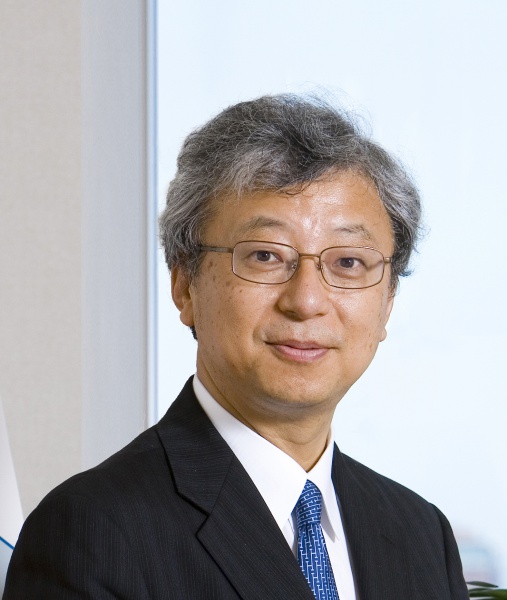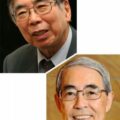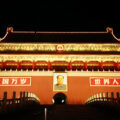A Nobel Prize Born of Healthy Argument
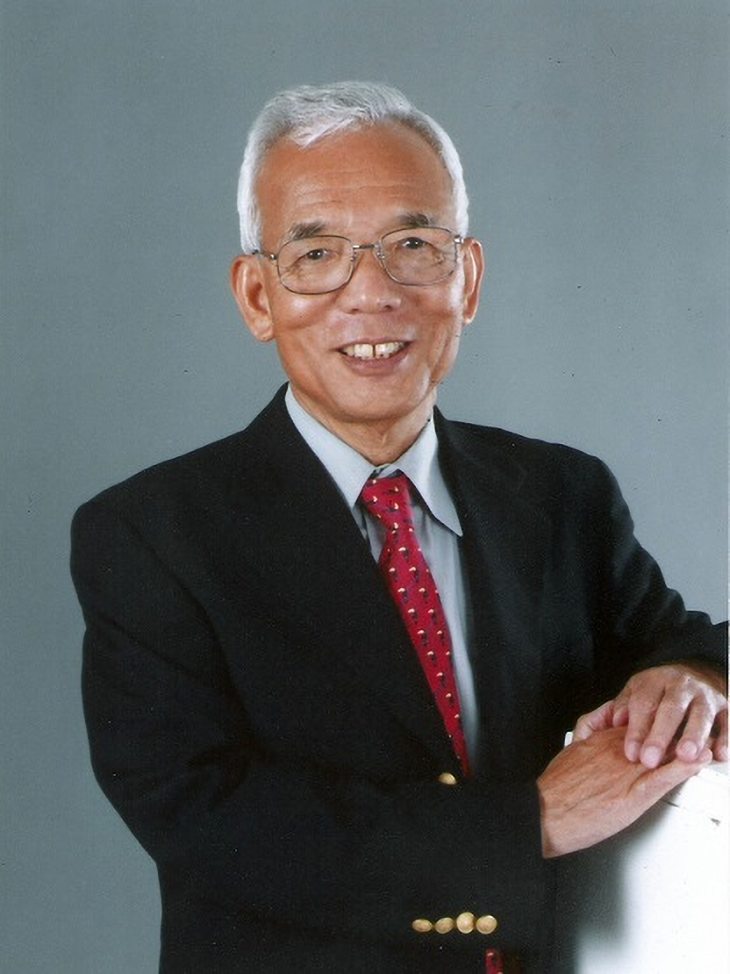
Dr. Manabe Syukuro, recipient of the Nobel Prize in Physics
Photo: Ministry of Education, Culture, Sports, Science and Technology
Manabe Syukuro, recipient of the Nobel Prize in Physics, interviewed at his home: Learn from your rivals and play to your strengths – the world-renowned 90-year-old authority shares the secrets to reaching the pinnacle of achievement
Interviewed by Tsuyama Keiko, journalist
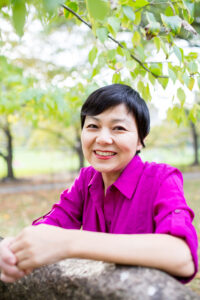
Tsuyama Keiko
When I look back on it, my life as a researcher has been a string of good luck. A paper I wrote back in graduate school happened to catch the attention of an American researcher and I was invited to the US. Then, at a research institute in the US, I was blessed with good supervisors and staff in a positive environment, and I was able to immerse myself in research with full access to a supercomputer.
That string of good luck continued all the way to receiving the Nobel Prize, but it truly came as a surprise. When you look at the list of past recipients of the Nobel Prize in Physics, it is dominated by people who have made significant contributions to the advancement of modern physics. The first Japanese person to receive the prize was Dr. Yukawa Hideki (1907–81), followed by Dr. Tomonaga Shinichiro (1906–79), and both made contributions to the field of quantum mechanics.
Although I received the Nobel Prize in recognition of making the world’s first contribution to the field of global warming through a paper I published in 1967, no one has received the prize for their achievements in the classical physics domain of climate research. That is why I was shocked. In most cases when someone receives a Nobel Prize, you hear about them as a contender for several years prior, but there were no such whisperings about me.
Of course, when I wrote that paper I had no idea that the issue of global warming would become so important. I suspect that not just myself, but everyone felt the same back then. At the time, there were probably only around ten people in the world who were interested in my research. Now it is being studied by thousands or tens of thousands of people across the globe.
In his will, creator of the Nobel Prize Alfred Nobel ordered his assets be distributed “as prizes to those who, during the preceding year, have conferred the greatest benefit to humankind.” I think the fact that the prize went to the field of climate change, which has never before happened, is significant in the sense that it suggests the Nobel Committee for Physics recognizes the extreme importance of this issue.
Opposing views are essential for scientific progress
I came to the United States in 1958, and I obtained US citizenship in 1975. In a press conference held immediately after the Nobel Prize announcements, I was asked why I had changed nationalities and I gave the following answer.
“[…] because I’m not capable of living harmoniously [in Japan].”
There are lot of things I want to convey to the Japanese people, including the truth behind this statement and the background of it.
I would like to take this interview as an opportunity to talk about a motto I have held dear while looking back at my life.
The first thing I want to say is that we should learn from disagreement, in other words from differences of opinion and opposition.
I am still working on research, and I argue with a certain researcher about the time scale at which the sea will stop absorbing carbon dioxide. Whenever I send him an email along the lines of “I disagree with your views on these points,” I immediately receive a reply.
The other day I wrote to him in an email, “I really enjoy the disagreements we have.”
Learning from disagreement is extremely important for science. But in Japan, it is rare for people to disagree with people to their face, even if they publish completely different research results. Even I am familiar with the desire to avoid tumultuous debate or hurting the feelings of the other person.
But in the US, we voice opposing opinions without reserve. That was the first impression I had of this country when I came here.
When you oppose something with a differing opinion of your own, you need to think about why you have a different opinion and specifically on what point. That is the seed that encourages you to think, “what is the reason I think my take is best?” and “what kind of research do I have to do to prove that what I think is right?”
Similarly, since the researcher on the other side of the debate will try to confirm that their own viewpoint is correct, if both parties share their research findings and verify them against one another, both parties can learn a lot from that. As a result, both scientists achieve great success in the future. In this way, pursuing research on the basis of differing views is essential to the progress of science.
In the recent press conference I was asked why I switched my nationality from Japan, and I answered as follows.
“In the US I can do as I like. I don’t worry too much about what other people think. As a matter of fact, I don’t want to hurt other people’s feelings, but I don’t observe them closely enough to figure out what they think. I find living in the US is wonderful!”
“I never wrote a single research proposal in my life. I get all the computers I need and can do whatever I please. So that is one reason why I don’t want to go back to Japan […]”
Research conducted by rivals informs my own research the most
Another important motto that I hold dear is to learn from your competitors.
When I look back on my life as a researcher to date, the most I have learned is from competing research. Whenever I think a competitor has a good idea, I immediately incorporate it into my own work. Imitating your rivals might seem to be a bad thing, but I did not hesitate to do so. To give an example, I would point to the work done by the researcher James Hansen (1941–), whose research on global warming is more famous than mine. When you look at his papers, he has some really good things to say. There were many times when by reading his papers, I was able to unlock something that had stalled my own research.
When you imitate your competitors’ ideas and put your own ideas on top of them, you can make significant progress in your research. That is something I experienced often. I have had several rivals in my research work, and their research has been the biggest benefit to my own.
The “learn from disagreement” that I just mentioned, and the idea of “learn from your competitors” may seem like different things on the surface, but they are closely related in the sense of learning from perspectives and opinions that differ from your own.
Play to your strengths and likes
The third thing I want to convey to the people of Japan is that you cannot beat the competition unless you do the things you are good at and the things you like.
From my perspective, Japanese people care a lot about appearances, and they tend to pick what they perceive as the cool thing in terms of the path they take in life, and even their field of research. What I want to say is don’t make choices based on superficial looks.
Rather than looking at whether something is “cool” or “uncool,” you have to choose the things you really like to do or are truly good at. When you choose a field you like or excel in, things get interesting, and you become absorbed in it. But if you want others to think you are “cool” and choose a path that you neither like nor particularly excel at, you won’t be devoted to that field, and you will never prevail against the competition.
This motto tracks closely with my own experiences. When I was in junior high school under the old system, I wanted to become a doctor. I was born in 1931 in Shinritsu Village (currently Shikokuchuo City) in Ehime Prefecture. Both my father and grandfather had been doctors, and my older brother was a doctor too. Being no exception, I too thought being a doctor was a great look, and I enrolled in what was then Osaka City Medical School (currently Faculty of Medicine, Osaka City University), but I quickly got the sense that this is simply not for me.
As this was around the time that universities were shifting to the new system of education, a year later in 1948 I moved on to the University of Tokyo, but I was clumsy, cutting the nerves of a frog during a dissection exercise and causing an explosion during a chemistry experiment. I was a mess.
It was around this time that I began to seriously think about whether a person as clumsy as myself was cut out to be a doctor. I asked myself what I would do if I didn’t become a doctor. After asking myself this question, I choose the path of a researcher who can take their time in tackling problems.
And when it came to deciding on a major, I had to choose whether to pursue theoretical physics or geophysics, and this was another time when I had to ask myself what I excelled at.
One thing that I noticed was that the people taking the same lectures as me who were going to major in theoretical physics had really sharp minds. It seemed to me that the field had attracted some of the best and brightest of Japan.
That is why I thought, given my abilities, if I pursue theoretical physics as a major, I won’t be able to compete, and so I opted for geophysics. The reason I decided to research weather is that I had long been interested in the curiosity of natural phenomena. So it was at this time that I chose something that reflected my own interests.
When you pursue learning in a well-established field, it may appear “cool” to those around you, but even if you produce some exceptional research findings in that field, it might be received as a “so-so” achievement. That’s because you are standing on the shoulders of so many talented people who have come before you. But if you blaze the path in a new field, like a blank canvas you can freely set your own narrative.
In this day and age, many people can freely access computers that can perform calculations at millions of times the speed of what I first used back then. Back in the day, we were the only ones who had access to these computers, and no one else could use them.
The data is also different. Now we can use artificial satellites to observe things like the state of the atmosphere, surface temperatures, dryness and rainfall. Even with seawater data, we have thousands of buoys around the world we can use to measures things like water temperature and oxygen content.
Since we have this extremely fortunate environment where we can increasingly use this data for research, I would say the younger generation of today is really lucky. I hope something lights a fire under them to spread their wings around the world to conduct research. That’s my hope.
Continue to study without retreating to the air-raid shelter
From here on I would like to look back on my life and talk about the chain of events that led to my coming to the United States, and the issue of global warming after that. As I mentioned earlier, I was born in a small village in Ehime Prefecture, and my father was the only doctor in the area.
From there I went on to the old Mishima Junior High School (currently Mishima High School) and it was around that time that American fighter planes were flying overhead and I remember them heading to Hiroshima and other major cities. I’m not sure if they were B-17s or B-29s, but many of them flew in and scattered incendiary bombs.
But they passed by Mishima, where my high school was located, without stopping. Maybe the US knew where the munitions factories were located. Since munitions factories are a bombing target, I wasn’t worried about being bombed. When American planes would fly overhead and everyone would run to the air-raid shelters, I would study.
At the time I was set on becoming a doctor, and since it was so hard to get into medical school, I needed to study a lot. I didn’t have the luxury of time to run away to an air-raid shelter, I told myself.
As I mentioned earlier, it turned out that I chose the path of a researcher and not that of a doctor.
Conducting research in a small hut-like structure
When I chose the path of a researcher and moved on to graduate school as one of the first students under the new university system, there were major developments in the world of meteorological research coming out of the United States.
John von Neumann (1903–57), described as the “Father of the Modern Computer,” chose climate modeling as the field in which computers could be used, and gathered up-and-coming researchers at the Institute for Advanced Study at Princeton University.
One of Neumann’s key accomplishments was the revelation that we must predict the weather based on the laws of physics. The group that Neumann assembled presented a trove of outstanding research. Our group of researchers at the Meteorology Course of the Geophysics Department at the University of Tokyo read the papers that were published and exclaimed “that’s it! This is a great idea!” We too began to conduct research into physics-based weather forecasts and numerical predictions. But since we still didn’t have access to computers, we performed our calculations from night to day with a labor-intensive approach.
Around that time the Geophysics Department was in quite a shabby hut-like structure in Ueno, but we were doing quite interesting research.
Personally, the research I conducted in that tiny shack ended up helping me a lot after I came to the US.
The reason I ended up going to the US was due to Joseph Smagorinsky (1924–2005), the research section chief of the National Oceanic and Atmospheric Administration (NOAA), part of the National Weather Service (NWS). He was engaged in similar research and invited me to the United States after reading a paper I had written. And yes, this was a paper I had written based on research done in that tiny shack.
From the turmoil of postwar Japan to the United States
Smagorinsky’s offer was met with a resounding “I’m on my way!” At that moment began my work that would last decades thereafter. This was nothing other than good luck.
However you look at it, Japan was locked in a postwar turmoil and there were no jobs available. If you were a researcher studying meteorological research at graduate school you might keep your place at the university or seek employment with the Central Meteorological Observatory (currently Japan Meteorological Agency) or a similar organization, but at the time the Central Meteorological Observatory was full of people from the Meteorological Department of the Imperial Japanese Army and Navy, and it was not clear if they were even looking to hire new people. And even if you try to find some other job, you can end up being shunned and unable to find work if you have a PhD from the graduate school of the University of Tokyo.
That is why I jumped at the opportunity and decided to move to the US. I didn’t know a lot about the research environment, but I suspected it would be better than the situation in postwar Japan. When I arrived, it turned out that my salary was 25 times higher than it had been in Japan, and most importantly, I had free use of a supercomputer, and I was able to throw myself into research. That is how I came to be in the US for so long. Since I came to the US in 1958, I spent 40 years at NOAA and used around 15 billion yen. Half of that was supercomputer usage fees, but it was paid for by the US government.
The top management at NOAA and Smagorinsky, who convinced them about what I was doing, had an amazing vision. In 1957, just before I arrived in the US, the Soviet Union’s artificial earth satellite Sputnik was launched, and orbited the earth with the dog Laika aboard. The achievement shocked the US, prompting then President John F. Kennedy to declare that “I believe that this nation should commit itself to achieving the goal, before this decade is out, of landing a man on the Moon and returning him safely to the Earth.” I believe there was a national policy of investing vast sums in scientific research for that purpose.
Even so, at the time no one knew how dire a problem global warming would be, so it was surprising that so much money was spent at a NOAA laboratory. What’s more, despite being someone from Japan, once the enemy of the United States, I was never discriminated against. I think there was still lingering resentment towards Japan in American society. There is no denying that. But within the laboratory at least, that was not something that was apparent to me.
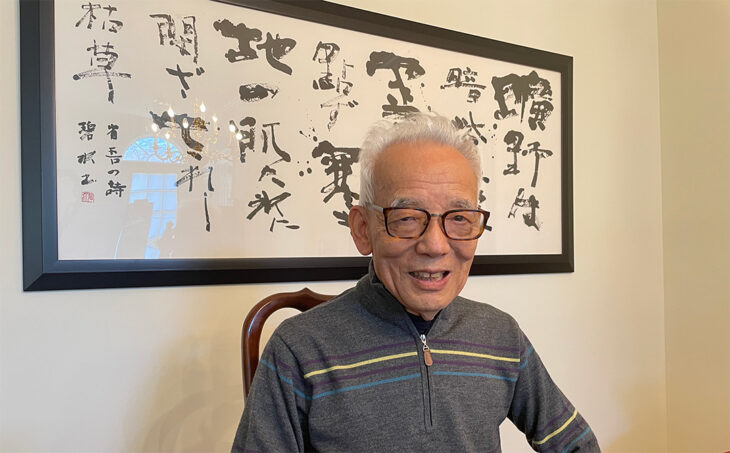
Dr. Manabe Syukuro speaking at his home in Princeton, New Jersey, January 6, 2022.
Photo: Tsuyama Keiko
The road to the Nobel Prize
When Smagorinsky invited me to the US I think he was around 35 years old. In the research team he put together by assembling young researchers from around the world, his goal was to advance existing climate modeling and create a “General Circulation Model” that would reproduce global atmospheric variations.
At the time, climate modeling involved performing calculations on the flow of air based on equations of motion to make predictions, but the problem was that we might have been able to make predictions across a range of one or two days, but couldn’t predict anything more than a week out.
Given that, the first thing we worked on was developing climate modeling. I was given the role of taking physical processes that had previously not been factored into climate modeling—things such as heat from the sun, atmospheric radiation, and evaporation from ocean and land surfaces—and incorporating them into climate modeling.
At the time, the ones conducting research into climate modeling were meteorologists, and the people who were predicting the weather each day had no interest in long-term issues such as atmospheric radiation. It wasn’t thought to be an issue that meteorologists needed to deal with. Even so, we cannot discuss the earth’s climate without considering sunlight. Those fundamental questions had been left unanswered.
Around this time, it was helpful that Tohoku University Professor Yamamoto Giichi (1909–80) was invited to the NWS. As he had originally specialized in physics, he had conducted research into atmospheric radiation. When creating the climate modeling I described earlier, his research was very influential. It is in tatters now but I still have the textbook that he wrote at home. I came to receive the Nobel Prize for research that incorporated elements such as atmospheric radiation into climate modeling.
I assumed that the atmosphere of the entire earth was a single column extending vertically. After incorporating the effects of atmospheric radiation and heat exchange (convection) between the upper and lower layers when energy from the sun is poured into that column, I reproduced the temperatures at each height of the column (altitudes in the atmosphere).
Using this model, I developed the physical modeling of the earth’s climate to show that when carbon dioxide concentration doubled from 300 ppm to 600 ppm, ground surface temperatures would rise two or three degrees. This was recognized as the first contribution to the global warming issue.
We can now create virtual models of the earth that combine the atmosphere, oceans and land surfaces and adjust the carbon dioxide concentration and intensity of sunlight at will. We can conduct various research using that model.
In the age of dinosaurs the earth’s climate was very warm, and if we increase the amount of carbon dioxide by around four times, we can reproduce the climate of that time. Conversely if we halve the carbon dioxide concentration from what it is now, we can reproduce a glacial age.
When the research of geologists was incorporated into those findings, we began to understand how the climate changed and how its carbon dioxide concentration varied over the past 500 million years. The evidence suggests that carbon dioxide not only defines future global warming, but has also had a big impact on climate change over the past 500 million years. We have now started to understand these things.
We can also explore what kind of effects diastrophism— deformations in the earth’s crust —have had on the climate. For example the Himalayas were formed when India collided with the Eurasian Continent, but if we set the elevation to zero in the model we can easily eliminate the Himalayas from the model. What is surprising when we do that is that the Gobi Desert in Central Asia is no more; instead, it is green.
On top of that, due to the Himalayas, northern India currently experiences a monsoon season of heavy rainfall every summer, but without the Himalayas that rainfall would occur near the equator.
These interesting problems keep coming up in the modeling, and you cannot help but enjoy yourself! [Laughs]
Thinking about the global warming issue
Finally I would like to give my thoughts about the issue of global warming. The most important question is how the climate will change as carbon dioxide in the atmosphere continues to increase and global warming advances in the future. Research is currently underway around the world to look at how factors such as rainfall, the flow of rivers and desertification is advancing.
Looking at Japan, recently western Japan has been experiencing torrential rainfall once every few years. On top of that the rainfall produced by typhoons of the same force has increased dramatically. This is simple according to the laws of physics, because when the temperature rises, the amount of water vapor in the air increases. If we put these statistics into the current model, we get clear results showing that the frequency of very strong rainfall will increase.
Meanwhile, global warming also increases the dryness of the soil. That is because when the atmosphere heats up, there is increased radiation of heat towards the earth’s surface. In fact, the dry Sahel region around the Sahara Desert is now experiencing a drought. More and more people will migrate to Europe because farming will become impossible. As drying increases, water shortages will also occur in the southwestern United States, and the frequency of forest fires in places like California will likely rise even further.
The biggest challenge is deciding what to do
But when people hear that global warming will increase torrential rains but also cause more droughts, it may strike them as contradictory. And I don’t think it is unreasonable for people to have that reaction. Even most experts don’t understand it well, and it is difficult for the experts to explain it in a way that laypeople can understand. I recently published a book on this problem, but it took me 15 years to write just 200 pages. It’s easy to say “global warming,” but explaining it well is no easy task.
We are now able to predict global warming quite well using climate models. People now understand that the disasters and extreme weather caused by global warming are a serious problem, and there is an awareness that something must be done.
But specifically what should be done? This is a question that is a hundred or a thousand times more difficult than understanding how the climate will change due to global warming. We have to take energy issues into consideration, and then there are problems that affect economies.
For example even though China and other countries are making various efforts to reduce carbon dioxide emissions, the use of coal has increased and it is being exported overseas as well. We know that the use of coal spreads air pollution and is harmful so we don’t want to use it, but the unavoidable situation is that there are people who rely on it.
We also need to consider the impact on water resources when the climate changes in the future. Then there are issues with agriculture as well.
We need to weigh all these issues and the costs of dealing with them in order to decide what action to take.
Translated from “Noberusho wa ronso kara: Manabe Syukuro (Noberu Butsurigakusho jushosha) Jitakude intabyu ni kotaeru (A Nobel Prize Born of Healthy Argument: Manabe Syukuro, recipient of the Nobel Prize in Physics, interviewed at his home),” Bungeishunju, March 2022, pp. 138-147. (Courtesy of Bungeishunju, Ltd.) [August 2022].
Keywords
- Manabe Syukuro
- meteorologist
- Nobel Prize in Physics
- Tsuyama Keiko
- supercomputer
- global warming
- climate change
- United States
- Japan
- research environment
- learn from disagreement
- Sputnik
- John von Neumann
- Joseph Smagorinsky
- General Circulation Model
- National Oceanic and Atmospheric Administration (NOAA)
- National Weather Service (NWS)
- Japan Meteorological Agency
- Yamamoto Giichi
- torrential rains
- drought

